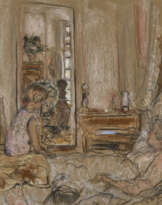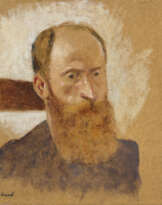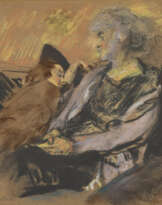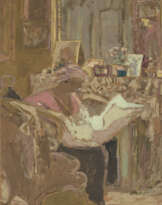ID 832289
Lot 165 | Édouard Vuillard (1868-1940)
Estimate value
€ 30 000 – 50 000
Portrait de Juliette Weil
signé 'E Vuillard' (en bas à droite)
pastel sur papier marouflé sur carton
64.8 x 50.5 cm.
Exécuté en 1927-28
signed 'E Vuillard' (lower right)
pastel on paper laid down on board
25 1/2 x 19 7/8 in.
Executed in 1927-28
Provenance
Atelier de l’artiste.
Ker-Xavier Roussel, L'Étang-la-Ville (acquis auprès de celui-ci).
Collection particulière, France (par descendance).
Collection particulière, Paris (acquis auprès de celle-ci dans les années 1950).
Puis par descendance au propriétaire actuel.
Literature
A. Salomon et G. Cogeval, Vuillard, Le Regard innombrable, Catalogue critique des peintures et pastels, Paris, 2003, vol. III, p. 1352, no. XI-111 (illustré en couleurs).
Post Lot Text
Juliette est l’épouse du Dr Prosper-Émile Weil (1873-1963), frère de Romain Coolus, proche de Léon Blum et habitué du cercle Hessel.
Hématologue de renom, il devint dans les années 1930 le médecin attitré de Vuillard. « Accompagné de Juliette et des enfants, Claudie et Alain, le docteur Weil fit de courts voyages en compagnie de Vuillard, à Vézelay en 1932, à Genève en 1938. Cela explique sa fréquente présence dans l'appartement de la place Vintimille dans les derniers mois de la vie de Vuillard, en 1940 » (G. Cogeval, op. cit., vol. III, p. 1350).
Juliette Weil devient quant à elle l’un des modèles favoris et l’une des muses privilégiées de l’artiste dès les années 1920, concurrençant directement Lucy Hessel. Guy Cogeval note en effet au sujet de la relation de l’artiste avec Juliette Weil : « nous croyons que l’amitié intellectuelle, puis l’amitié tout court ont prévalu. Et Juliette Weil entoura Vuillard de l’affection de sa famille. Il serait peut-être de dire qu’elle était infatuée de Vuillard. […] Avec Lucy, elle fit partie de ces femmes qui considèrent que s’attacher à un artiste doué et célèbre revêt les allures d’un destin historique » (G. Cogeval, op. cit., vol. III, p. 1349).
Vuillard exécute ainsi de nombreux tableaux, pastels et œuvres sur papier de Prosper-Émile Weil et Juliette Weil dès les années 1920 dont le présent ensemble particulièrement inédit et émouvant, est resté dans la famille du couple jusqu’à aujourd’hui.
Juliette was the wife of Dr Prosper-Émile Weil (1873-1963), brother of Romain Coolus, a close friend of Léon Blum and a regular in the Hessel circle.
He was a renowned haematologist and became Vuillard’s official doctor in the 1930s. “With Juliette and the children, Claudie and Alain, by his side, Doctor Weil accompanied Vuillard on short trips to Vézelay in 1932, and Geneva in 1938. This explains his frequent presence in the apartment on Place Vintimille during the last few months of Vuillard’s life, in 1940” (G. Cogeval, op. cit., vol. III, p. 1350).
Juliette became one of the artist’s favourite models and muses from the 1920s, in competition with Lucy Hessel. As Guy Cogeval notes, in the artist’s relationship with Juliette Weil, first “intellectual friendship and then just friendship prevailed. And Juliette surrounded him with the affection of her family. One could say she was infatuated with Vuillard. […] Like Lucy, she was one of those women who considered that forming an attachment with a gifted and famous artist was tantamount to embracing a historical destiny” (G. Cogeval, op. cit., vol. III, p. 1349).
Vuillard thus executed numerous paintings, pastels and works on paper of Prosper-Émile Weil and Juliette Weil from the 1920s. This particularly unique and moving series has remained in the couple’s family until today.
| Artist: | Édouard Vuillard (1868 - 1940) |
|---|---|
| Applied technique: | Pastel on paper |
| Artist: | Édouard Vuillard (1868 - 1940) |
|---|---|
| Applied technique: | Pastel on paper |
| Address of auction |
CHRISTIE'S 9 Avenue Matignon 75008 Paris France | ||||||||||||||
|---|---|---|---|---|---|---|---|---|---|---|---|---|---|---|---|
| Preview |
| ||||||||||||||
| Phone | +33 (0)1 40 76 85 85 | ||||||||||||||
| Fax | +33 (0)1 40 76 85 86 | ||||||||||||||
| Conditions of purchase | Conditions of purchase | ||||||||||||||
| Shipping |
Postal service Courier service pickup by yourself | ||||||||||||||
| Payment methods |
Wire Transfer | ||||||||||||||
| Business hours | Business hours
|















